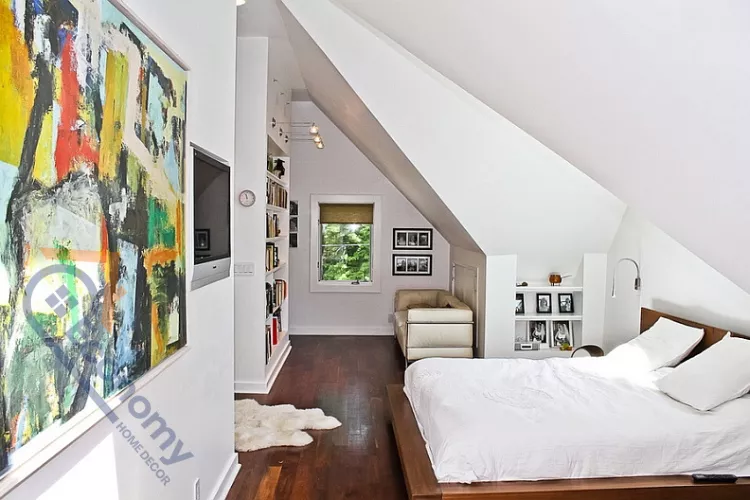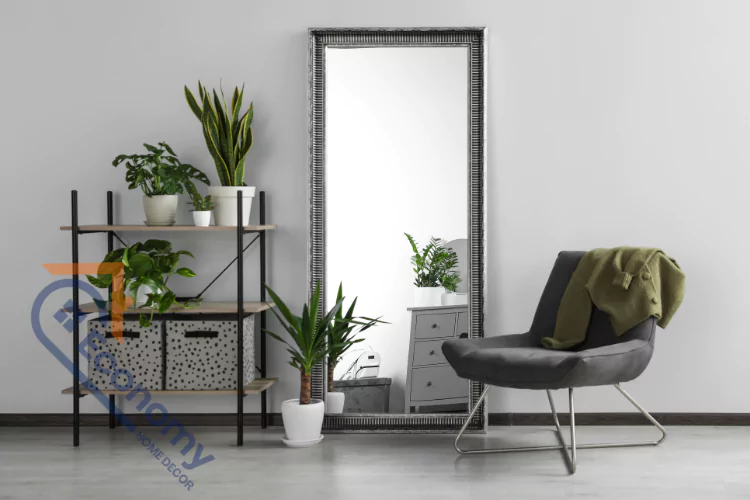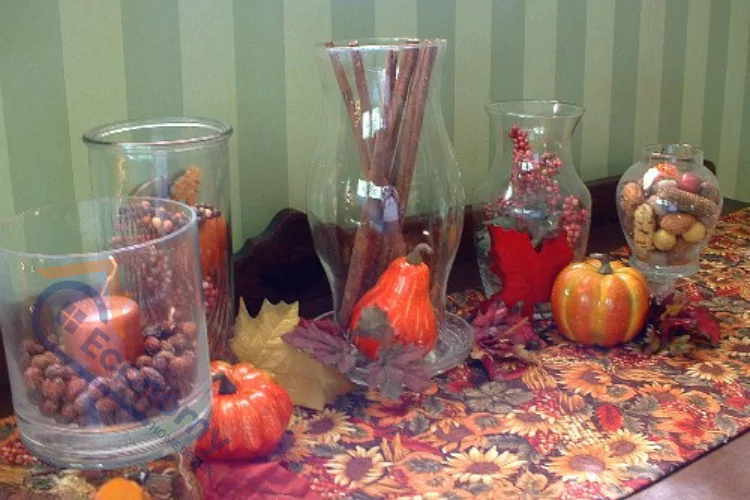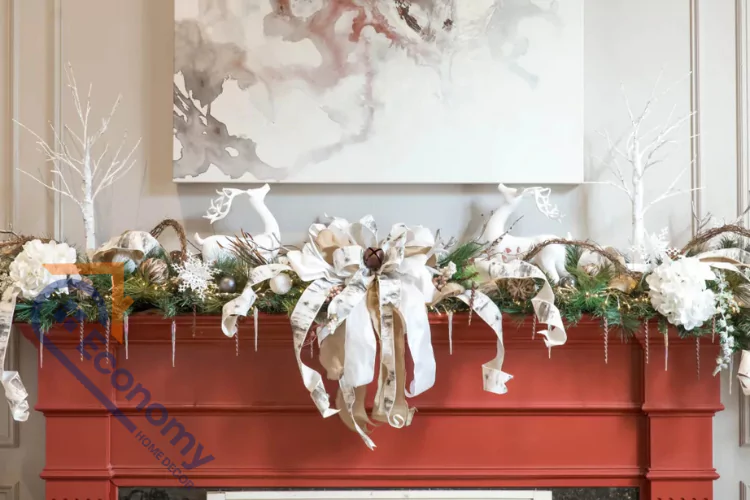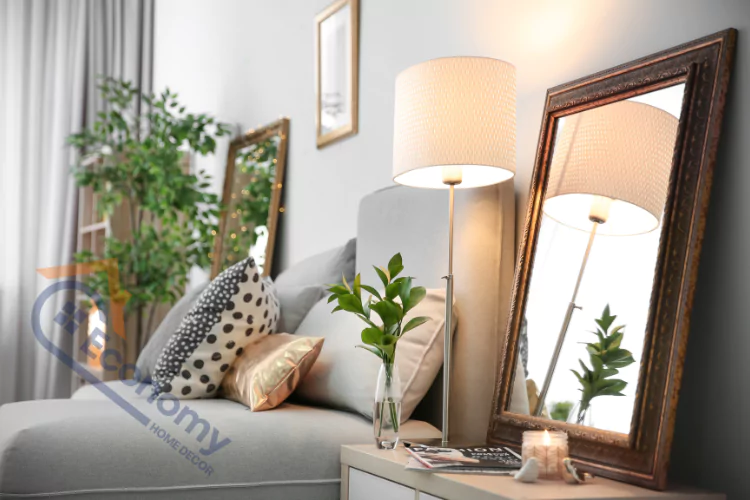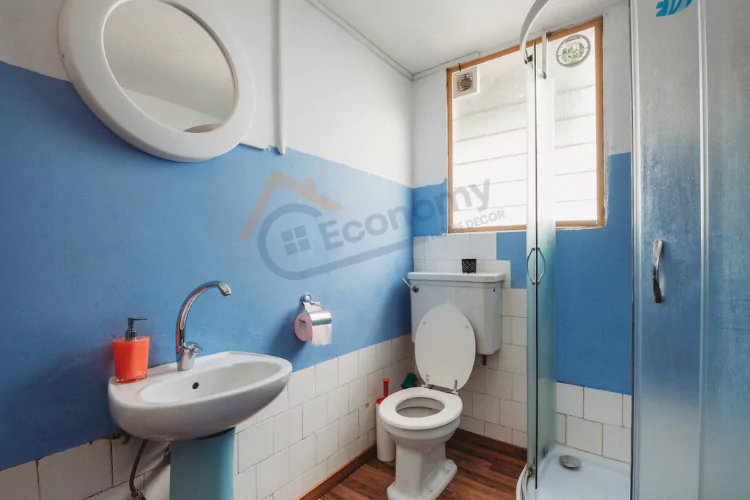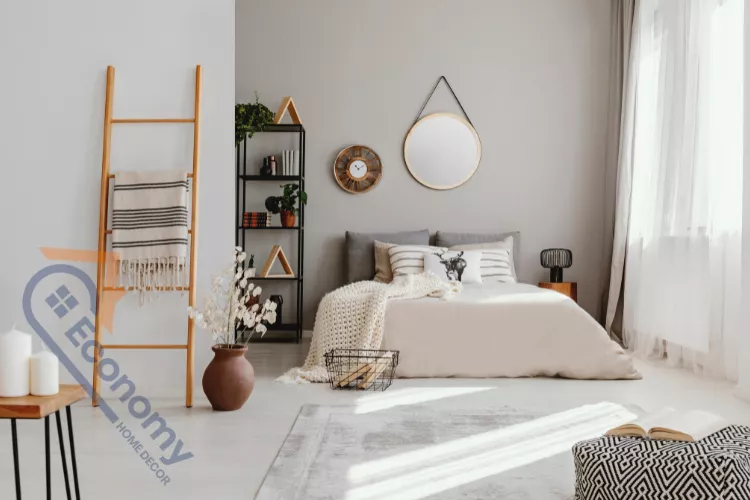Do you have a room with slanted walls that feels impossible to decorate? You’re definitely not alone! Many homeowners struggle with how to decorate slanted walls, especially in attics, bonus rooms, or bedrooms tucked under the roofline. These angled spaces can feel awkward and challenging, but here’s the good news: slanted walls are actually hidden gems that can add unique character and charm to your home. With the right approach and creative slanted wall decor ideas, you can transform these tricky spaces into stunning focal points that maximize every inch of your room. Let’s explore 25 amazing ways to make those angled walls work beautifully for you!
Key Takeaways
- Slanted walls offer unique decorating opportunities that can add character to your space
- Strategic furniture placement and wall decor can maximize functionality in rooms with angled ceilings
- Lighting plays a crucial role in enhancing slanted wall areas
- Color choices and patterns can either emphasize or minimize the slanted effect
- Built-in solutions and custom furniture work exceptionally well with slanted walls
Why Slanted Walls Deserve Your Attention
Before diving into specific decorating ideas for slanted walls, let’s talk about why these architectural features are worth embracing rather than hiding. Slanted walls typically appear in homes with vaulted ceilings, A-frame designs, or converted attic spaces. While they might seem like design challenges, they actually create cozy, intimate spaces that feel more interesting than standard rectangular rooms. The key to successful slanted wall decor lies in understanding that these walls aren’t obstacles—they’re opportunities to showcase your creativity and maximize your living space in unexpected ways.
When you’re figuring out how to decorate slanted walls bedroom spaces or living areas, remember that millions of homeowners face the same challenge. The difference between a cramped-feeling room and a charming retreat often comes down to thoughtful decoration choices. Whether you’re working with a slight angle or a dramatic slope, the right decor for slanted walls can completely transform how the space looks and feels.
Understanding Your Slanted Wall Space
The first step in decorating a slanted wall is understanding what you’re working with. Measure the height of your walls at different points, note where the slope begins, and identify any awkward corners or unusually shaped areas. This information becomes invaluable when you’re planning how to decorate a slanted wall bedroom or any other room. Take photos from multiple angles so you can visualize different slanted wall decorating ideas before committing to purchases.
Consider the room’s purpose and how the slanted walls affect functionality. In bedrooms, you’ll need to think about bed placement and storage solutions. In living rooms, you’ll focus on seating arrangements and entertainment areas. Understanding these practical needs helps you choose wall decor for slanted walls that’s both beautiful and functional. Remember that different sections of your slanted wall might serve different purposes—the lower portions are perfect for furniture placement, while higher areas are ideal for visual interest through art and decorative elements.
Strategic Furniture Placement for Slanted Walls
One of the smartest slanted wall decor ideas involves using furniture to your advantage. Low-profile furniture works beautifully along slanted walls because it doesn’t fight against the angle. Consider placing dressers, low bookcases, or benches against the shortest part of the wall. This approach makes the most of otherwise unusable space while keeping the room feeling open and uncluttered.
When you’re learning how to decorate a bedroom with slanted walls, think about positioning your bed under the highest point of the ceiling. This creates a grand, dramatic effect while leaving the lower slanted areas for practical storage furniture. For decorating bonus room with slanted walls, try creating distinct zones—maybe a reading nook in the low-ceiling area with a comfortable chair and small side table, while using the taller spaces for standing activities. Built-in furniture deserves special mention here because custom pieces can be designed to fit perfectly against your slanted walls, creating seamless storage solutions that look intentional rather than awkward.
Gallery Wall Magic on Slanted Surfaces
Creating a gallery wall is one of the most popular decorating ideas for slanted walls, and for good reason! A collection of frames, photos, artwork, and mirrors can follow the angle of your wall, creating visual interest that celebrates the slope rather than fighting it. Start by arranging your pieces on the floor first, playing with different layouts until you find one that feels balanced and flows with the wall’s angle.
When figuring out how to decorate slanted attic walls with gallery arrangements, mix different frame sizes and styles for an eclectic, collected-over-time look. You can also use matching frames for a more cohesive, sophisticated appearance. The beauty of this slanted ceiling wall decor approach is its flexibility—you can easily add or remove pieces as your style evolves. Consider including three-dimensional elements like small shelves, decorative plates, or sculptural pieces to add depth. For decorating slanted wall bedroom spaces, personal photos mixed with inspirational quotes create a warm, intimate atmosphere that makes the unique wall shape feel like an intentional design feature.
Paint and Color Strategies
| Color Strategy | Effect on Space | Best For |
|---|---|---|
| Light, neutral colors | Makes room feel larger and brighter | Small rooms, rooms with limited natural light |
| Dark, bold colors | Creates cozy, intimate atmosphere | Large rooms, creating dramatic focal points |
| Accent wall on slanted surface | Draws eye upward, emphasizes architecture | Rooms where you want to celebrate the slope |
| Continuous color from wall to ceiling | Minimizes the slanted effect | When you prefer a more traditional look |
| Horizontal stripes | Makes walls appear wider | Narrow rooms with slanted walls |
Paint choices dramatically impact how to decorate slanted walls in bedroom and living spaces. Light colors reflect natural light and make slanted ceilings feel higher and more spacious. Whites, soft grays, and pale pastels work wonderfully for decorating rooms with slanted walls when you want an airy, open feeling. These shades help bounce light around the room, which is especially important in attic spaces that might have limited windows.
Alternatively, embracing darker colors on slanted walls creates a cozy, cocoon-like effect that can be incredibly comforting in bedrooms. Deep blues, rich greens, or warm charcoals make slanted ceilings feel intentional and dramatic rather than awkward. When you’re considering how to decorate a wall with a slanted ceiling using paint, try painting the slanted portion a different color than vertical walls to clearly define the architectural feature. You might also experiment with wallpaper on slanted surfaces—patterns can add visual interest and distract from the unusual angles while adding personality to your space.
Lighting Solutions That Shine
Proper lighting is absolutely essential when decorating slanted walls living room and bedroom areas. The angles create shadows and can make spaces feel darker than rooms with standard ceilings, so strategic lighting becomes one of your most important slanted walls decor tools. Start with overhead lighting—recessed lights or track lighting work exceptionally well because they can be angled to illuminate specific areas without hanging down into walkways.
Wall sconces are perfect for decorating a slanted wall because they provide ambient lighting while taking up minimal space. Mount them at varying heights along the slope to create layers of light throughout the room. For how to decorate rooms with slanted walls effectively, consider adding uplighting that washes the slanted ceiling with soft light, making the space feel taller and more open. Floor lamps and table lamps add pools of warm light in corners and reading areas. String lights or LED strips along the angle where the wall meets the ceiling create a magical, modern effect that’s particularly popular for decorating ideas bedroom slanted walls in teen and young adult spaces.
Textile and Fabric Treatments
Soft furnishings offer wonderful decorations for slanted walls that add warmth and texture without requiring wall mounting. Hanging fabric panels or curtains can soften the angular lines while providing practical benefits like hiding storage areas or creating privacy zones. When you’re figuring out how to decorate a room with slanted walls, consider draping lightweight fabric from the highest point down to create an elegant canopy effect, especially beautiful in bedrooms.
Tapestries and textile wall hangings are excellent wall decor for slanted ceilings because they’re lightweight, easy to hang, and add significant visual impact. Macramé pieces, quilts, or woven wall hangings bring texture and interest to slanted surfaces while their flexible nature works with angles more easily than rigid artwork. For decorating a large slanted wall, a oversized tapestry or rug hung as art creates a stunning focal point. Consider layering different textiles—perhaps combining curtains with throw pillows and bedding in coordinating patterns—to create a cohesive look that ties the entire room together despite its unusual architecture.
Shelving and Storage Solutions
Custom shelving represents some of the best way to decorate slanted wall spaces because it combines form and function beautifully. Floating shelves installed at varying heights along the slope create practical storage while serving as display space for decorative objects, books, and plants. When planning how to decorate slanted walls bedroom areas, consider built-in shelving units designed specifically to fit the angle—these maximize every bit of space while looking seamlessly integrated.
Corner shelving units work particularly well in rooms with slanted walls because they utilize those tricky angled corners that are often wasted space. For decorate room with slanted walls effectively, think vertically with tall, narrow bookcases positioned against the highest walls, then transition to lower storage as the ceiling slopes down. Open shelving keeps the space feeling airy, while closed cabinets hide clutter in less visually appealing areas. Creative storage solutions like under-eave drawers, built-in window seats with storage underneath, or custom closet systems transform the challenges of slanted walls into organizational opportunities that actually increase your usable space.
Mirror Placement for Visual Expansion
Mirrors are magical when you’re learning how to decorate a slanted wall in living room or bedroom spaces because they reflect light and create the illusion of more space. A large mirror positioned on a slanted wall opposite a window doubles the natural light in the room while making the ceiling appear higher. This simple trick makes even small attic rooms feel significantly more spacious and bright.
When considering decorate slanted walls with mirrors, think beyond traditional rectangular shapes. Circular mirrors, grouped smaller mirrors, or uniquely shaped vintage mirrors add personality while serving the practical purpose of light reflection. For decorating ideas for bedrooms with slanted walls, try leaning an oversized floor mirror against the shortest section of wall—this casual arrangement feels modern and doesn’t require finding studs in challenging angles for mounting. Mirrored furniture pieces like nightstands or dressers amplify the light-reflecting effect. Just be mindful of placement to avoid creating odd reflections or making the room feel too busy with competing visual elements.
Plant Life and Natural Elements
Bringing nature indoors through plants and natural materials is a refreshing approach to slanted walls decor that adds life and color to challenging spaces. Hanging plants work exceptionally well with slanted ceilings because they draw the eye upward while softening angular lines. Install ceiling hooks at various points along the slope to create a cascading garden effect with trailing plants like pothos, string of pearls, or ivy.
For how to decorate wall with slanted ceiling using plants, consider wall-mounted planters at different heights along the angle. This creates visual interest while making the slanted wall feel intentional and designed rather than awkward. Tall floor plants positioned at the highest ceiling points add vertical elements that complement the architecture. When you’re working on decorate a large bedroom with slant walls, a collection of plants in various sizes creates a mini indoor garden that brings freshness and improves air quality. Natural wood elements like driftwood wall art, branch installations, or wooden shelving add organic warmth that pairs beautifully with the cozy feeling slanted walls naturally create.
Architectural Features to Embrace
Sometimes the best decorating slanted walls living room or bedroom approach is highlighting rather than hiding the architectural features. Exposed beams on slanted ceilings can be painted in contrasting colors to create dramatic visual interest, or left natural for rustic charm. If your slanted walls include unique features like built-in nooks, dormer windows, or unusual angles, celebrate these elements as character-defining features rather than problems to solve.
For decorate a very slanted wall in the living room effectively, consider adding decorative molding or trim that follows the angle, creating a frame effect that makes the slope look purposeful and polished. Shiplap, board-and-batten, or tongue-and-groove paneling installed on slanted surfaces adds texture and dimension while embracing the cottage or farmhouse aesthetic many people love in attic spaces. When you’re planning how to decorate a slanted wall bedroom with architectural emphasis, think about painting ceiling beams, adding corbels, or installing decorative brackets that draw attention to the unique structure rather than trying to minimize it. These elements tell a story about your home’s character and make your space feel custom and special.
Creating Functional Zones
One of the smartest decorating bonus room with slanted walls strategies involves dividing the space into functional zones that work with the ceiling heights rather than against them. Use the lowest ceiling areas for activities that don’t require standing—perhaps a cozy reading corner, a meditation space, or a kids’ play area where little ones don’t need full ceiling height. The medium-height sections work perfectly for sitting areas with sofas and chairs, while the tallest portions can accommodate standing activities, entertainment centers, or workspace.
When considering how to decorate rooms with slanted walls using a zoning approach, area rugs help define separate spaces within one room. A rug under a seating group, another under a desk area, and a third defining a sleeping zone creates clear purpose for each section despite the challenging ceiling angles. Furniture arrangement naturally reinforces these zones—low bookcases or a sofa back can serve as subtle dividers between areas. For decorating rooms with slanted walls, lighting also plays a role in defining zones, with different light sources for different activities creating distinct atmospheres within the single space.
Artwork and Wall Decor Arrangements
Choosing and arranging wall decor for slanted ceilings requires slightly different thinking than decorating standard vertical walls. The key is working with the angle rather than trying to create perfectly level arrangements. Large-scale artwork makes a bold statement on slanted walls—a single oversized piece or a triptych arranged to follow the slope creates impressive visual impact without looking cluttered.
When planning how to decorate a slanted wall with artwork, consider the viewing angle from different parts of the room. Art positioned on a slanted wall will be viewed from below, so choose pieces that look good from that perspective. Abstract art, landscapes, and geometric designs typically work better than portraits on severely angled walls. For decorate slanted living room walls, mix 2D art with 3D sculptural pieces to add depth. Plate collections, decorative baskets, or metal wall sculptures create interesting shadows and dimension. The best way to decorate slanted wall surfaces is often layering different types of decor—perhaps combining framed art with floating shelves displaying small objects, creating a collected, curated look that makes the unusual wall shape feel like an intentional design opportunity.
Window Treatments for Slanted Windows
Many rooms with slanted walls also feature unusually shaped windows—dormer windows, skylights, or angled windows that require special treatment. These windows present unique challenges when you’re figuring out how to decorate a bedroom with slanted walls, but they’re also opportunities to add character and light. For dormer windows, consider custom cushions on the window seat area below, creating a cozy nook perfect for reading or relaxing.
Skylights on slanted ceilings bring wonderful natural light but may need shading options. Remote-controlled blinds designed specifically for skylights allow you to control light levels without requiring a ladder. For angled windows along slanted walls, custom curtains or Roman shades that follow the window’s shape create a polished, finished look. When planning decorating slanted wall bedroom spaces with prominent windows, treat these as focal points rather than trying to minimize them. Frame them with light-colored paint, add plants on window sills, or hang crystals that create rainbow light patterns throughout the room. The goal with window treatments in slanted-wall spaces is balancing privacy and light control while celebrating these architectural features rather than hiding them.
Conclusion
Decorating slanted walls doesn’t have to be frustrating or limiting—in fact, these unique architectural features offer incredible opportunities to create spaces with personality and charm that standard rectangular rooms simply can’t match. Whether you’re working on how to decorate slanted walls bedroom areas, tackling a bonus room, or transforming an attic living space, the 25 ideas we’ve explored give you plenty of options to maximize your space beautifully.
Remember that the most successful slanted wall decor ideas embrace the angles rather than fighting them. Use strategic furniture placement, thoughtful lighting, creative storage solutions, and decorative elements that celebrate your room’s unique architecture. Mix practical solutions like custom shelving with aesthetic touches like gallery walls and plants to create spaces that are both functional and beautiful.
Your slanted walls tell a story about your home’s character—they indicate interesting rooflines, cozy attic spaces, or architectural features that set your house apart. By approaching these spaces with creativity rather than frustration, you’ll discover that decorating slanted walls living room and bedroom areas becomes an enjoyable design challenge that results in truly special spaces you’ll love for years to come.
Frequently Asked Questions
What is the best way to decorate slanted wall in a small bedroom?
The best approach for small bedrooms with slanted walls combines light colors to maximize the sense of space, strategic furniture placement using low-profile pieces along the shortest walls, and vertical storage solutions like wall-mounted shelves. Keep decor minimal but impactful—a few well-chosen pieces make more impact than cluttering the space with too many items.
How do I hang pictures on slanted walls?
Use heavy-duty picture hanging strips designed for walls, picture rail systems that can be adjusted for angles, or install a picture ledge shelf that follows the wall’s slope. For heavier items, locate studs and use appropriate hardware. Gallery wall arrangements that follow the slant often look more intentional than trying to hang pieces level.
Should I paint slanted walls the same color as regular walls?
This depends on your goal. Painting slanted walls the same color as vertical walls minimizes the architectural feature and creates flow, making the room feel more cohesive. Painting slanted sections a different color emphasizes the unique architecture and can create dramatic focal points. Both approaches work—choose based on whether you want to highlight or downplay the angles.
What kind of furniture works best with slanted walls?
Low-profile furniture like platform beds, short dressers, and floor cushions work exceptionally well because they don’t compete with the ceiling height. Built-in furniture custom-designed for the space maximizes functionality. Avoid tall furniture like highboys or armoires in the lowest ceiling areas.
How can I make a room with slanted walls feel bigger?
Use light, neutral paint colors on walls and ceilings, incorporate multiple light sources including uplighting, strategically place mirrors to reflect light, keep floor space clear with wall-mounted storage, and use furniture that’s appropriately scaled to the space. Avoid heavy, dark colors and cluttered arrangements that make the room feel cramped.
Are slanted walls good or bad for home value?
Slanted walls are neutral for home value when decorated well—they indicate finished attic or bonus space, which is desirable square footage. The key is presenting these rooms as functional, attractive spaces rather than awkward afterthoughts. Well-decorated rooms with slanted walls can actually be selling points that demonstrate creative space utilization and add character to a home.

